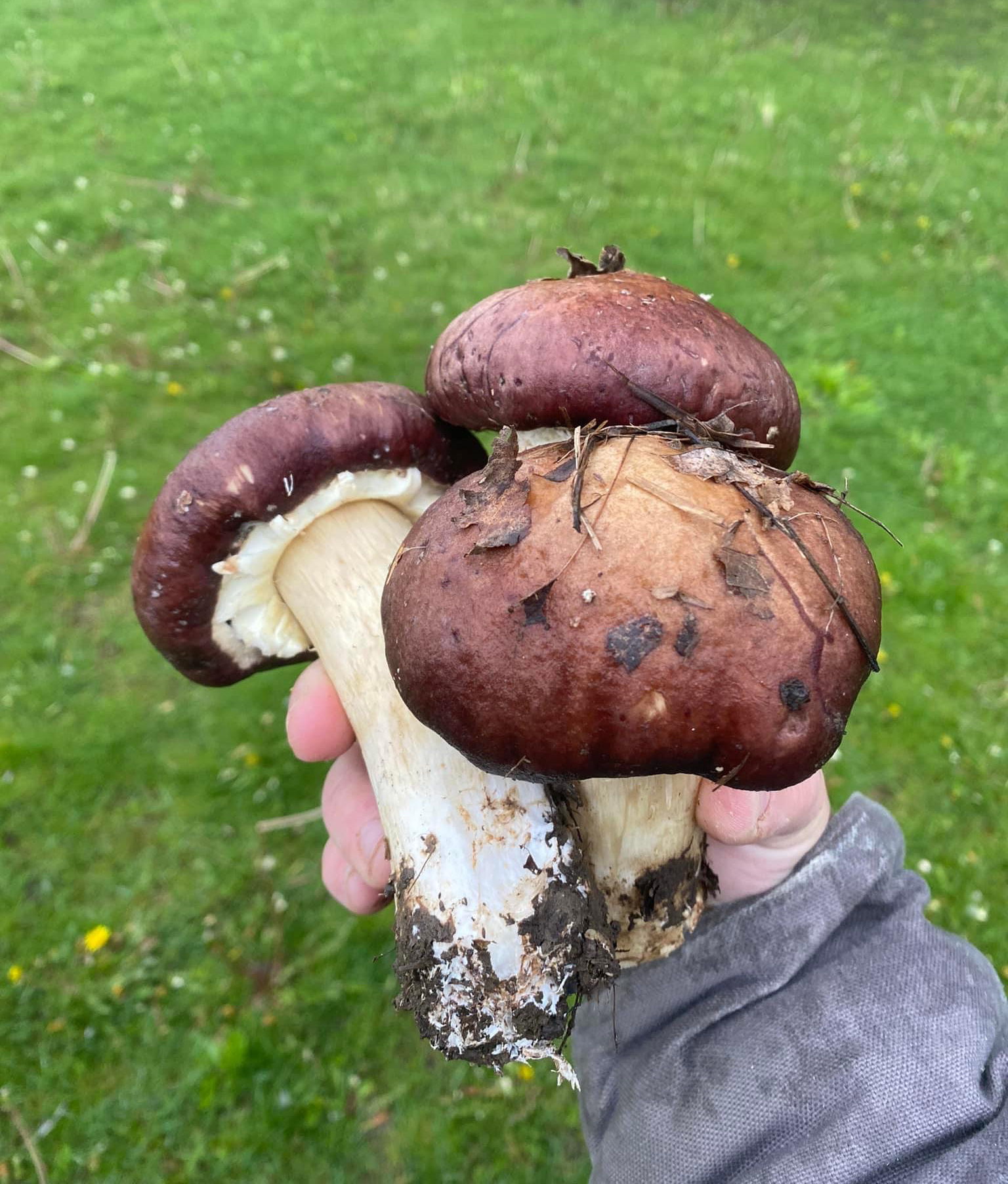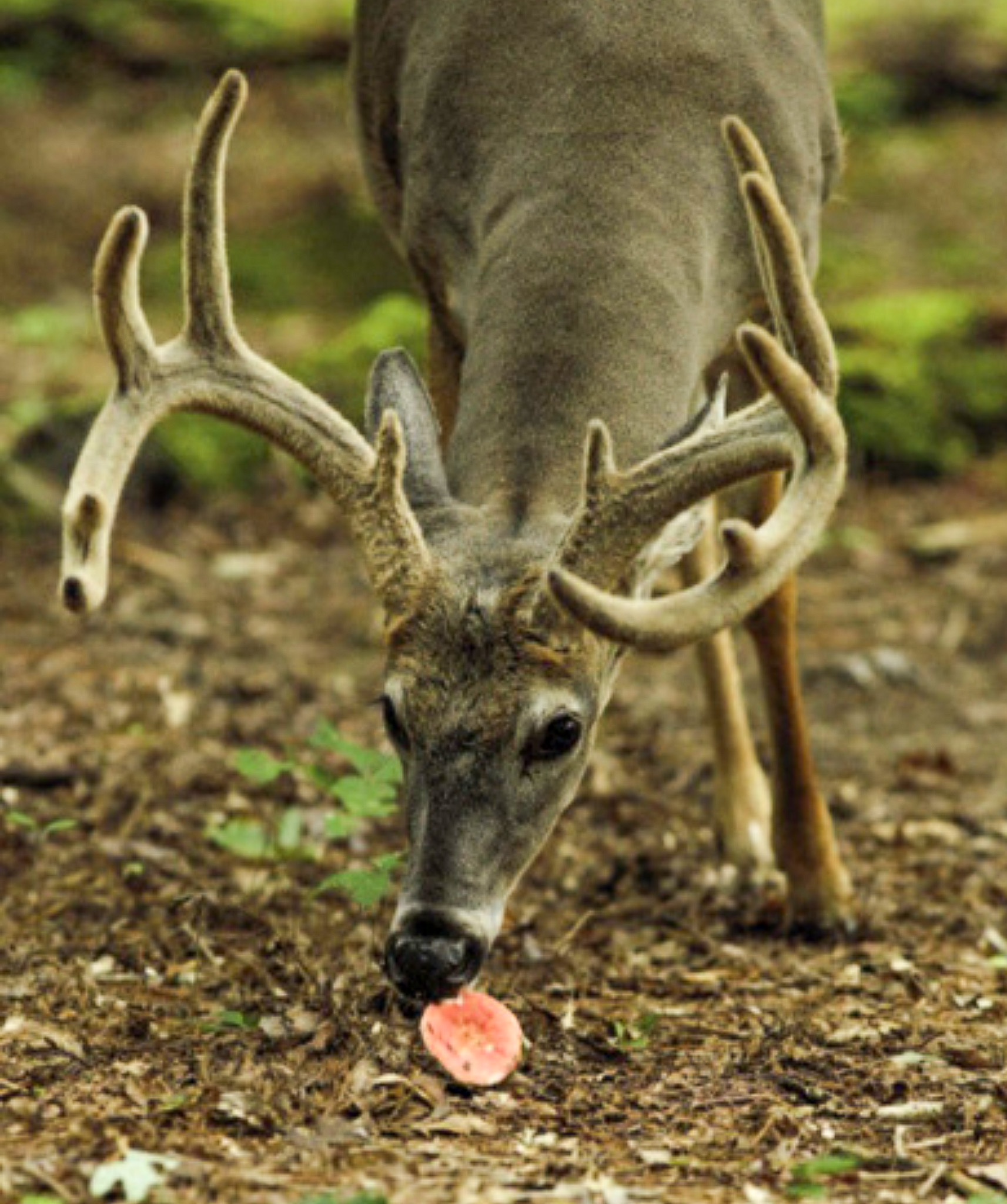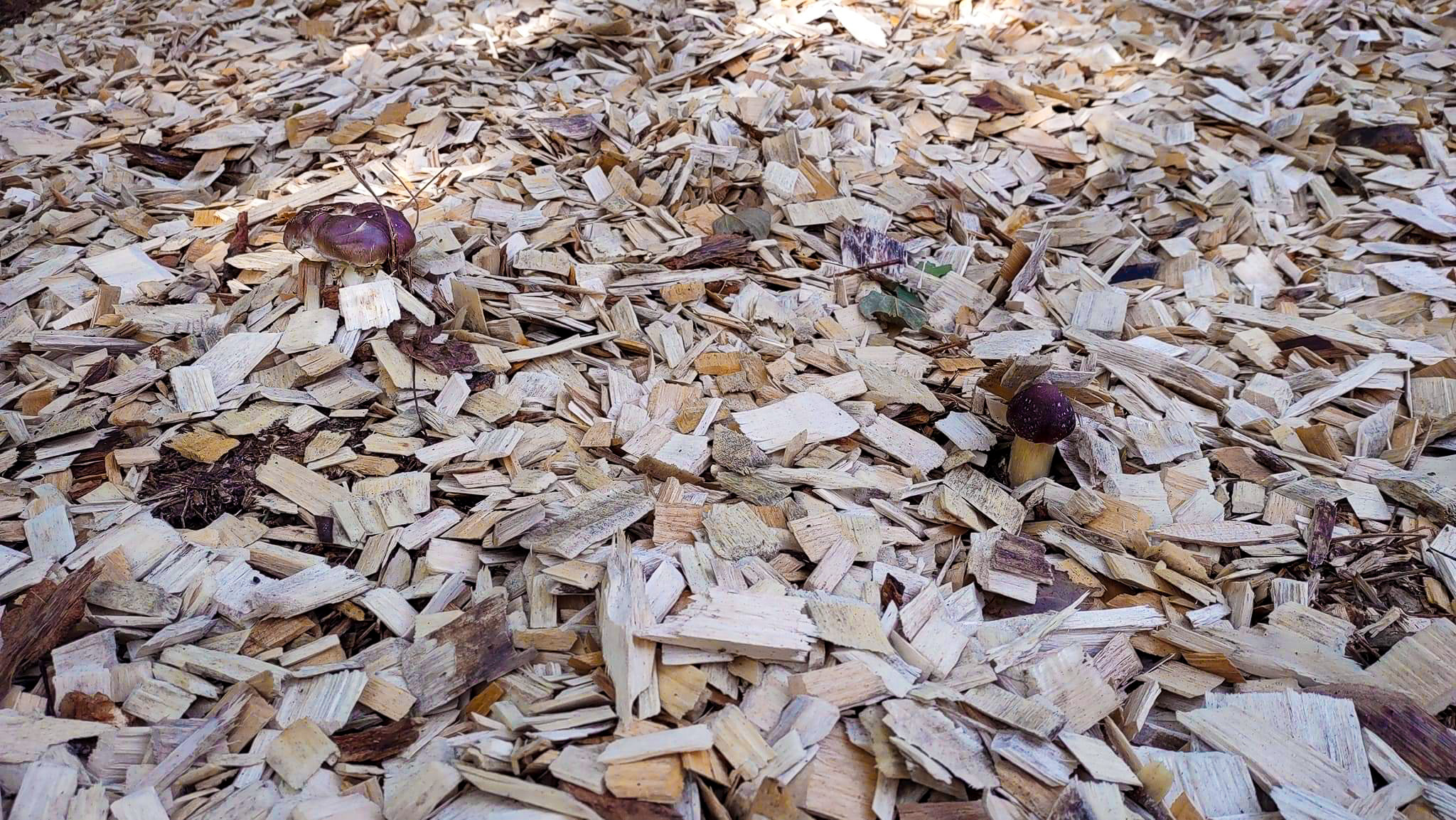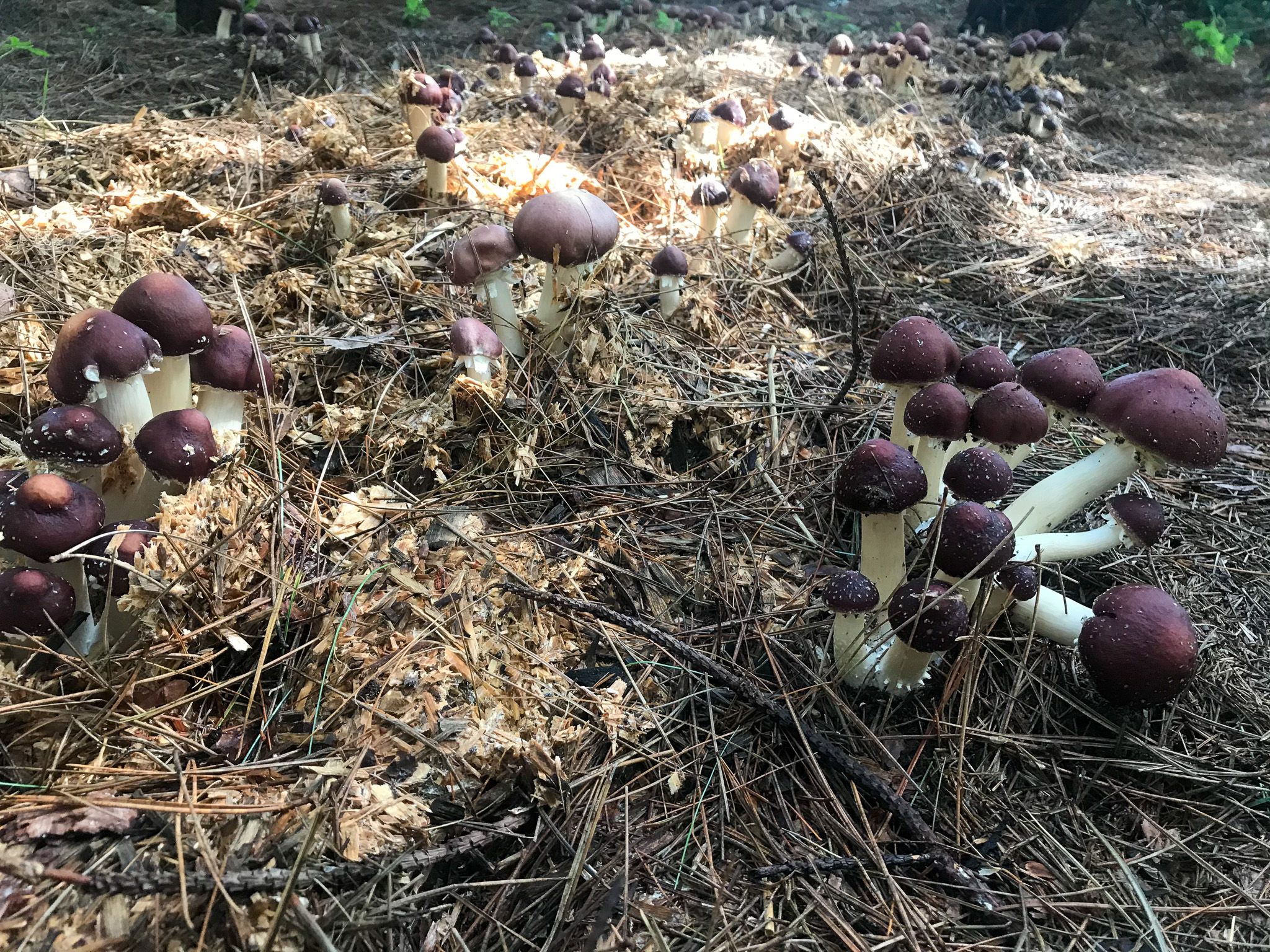At first, Matt Williams thought someone might be stealing his mushrooms.
The tops of the wine cap mushrooms growing on his Wisconsin farm had been removed at the stems, the way a forager might slice away a meaty morel. But when closer inspection revealed evidence of nibbling on the stems and tracks in the dirt, he knew he wasn’t dealing with human trespassers.
“It was like, ‘Where’d all these mushrooms go that I was gonna pick today? Well, they’re all gone because the deer and the turkeys were in here.’ And that’s where it really all began,” says Williams. “At a certain point I began to sit back and say, ‘You know, I’m tired of fighting with these deer.’ Why are they eating these [wine caps]? There’s alfalfa and silage corn [nearby], the neighbors have food plots and brassicas, and all these things that they’re supposed to love. And the deer are eating this?”
When he turned to the internet to research deer and mushrooms, Williams says he found conflicting reports. At the time he was growing a variety of fancy mushrooms for farmers markets and upscale restaurants; he estimates he had the biggest mushroom fruiting yard in the state of Wisconsin. Yet deer seemed to be primarily targeting the wine caps (the purple-topped mushrooms are also known as Stropharia rugosoannulata, king Stropharia, compost giant, and garden giant). Wine caps are relatively affordable, easy to grow, and fruit multiple times a year. So in 2018 Williams tried planting a massive trap crop of wine caps — a sort of sacrificial offering to the local deer.
Trail cam footage taken during August and Sept. 2023 at Williams’ original wine cap plot that he planted in 2018, which hasn’t had any annual maintenance since he moved.
“We’re giving the predators and the wee beasties something to eat so they leave our best crops alone. And I figured I would get some [mushrooms] out of it, too,” says Williams. “And it just worked to the opposite effect. They destroyed those Stropharia [and] it brought more deer in than were already there.”
That’s when everything clicked. Now, instead of waging war with whitetails, Williams focuses full-time on growing and selling mushroom spawn to food plotters and habitat managers through his family business, MycoHabitat. He’s since moved to a farm near Iron Mountain, just across the state line to Michigan’s Upper Peninsula, where he hunts (and kills) deer over his own mushroom food plots.
While a handful of hunters seem aware of this trend, few have actually tried making mushroom plots. Here’s how Williams thinks about this nutritious and attractive food source for deer and other wildlife, how he recommends planting a mushroom food plot (yes, there’s still time this season), and why the plots are so easy to maintain.
How to Make a Mushroom Food Plot

After his own conversion to the not-so-radical idea that deer eat mushrooms, Williams tried spreading the word. He was laughed off Facebook by average deer hunters, who suggested (to put it mildly) that he was full of crap. So Williams turned to established deer biologists, habitat managers, and other industry experts to make his case. One of those open-minded hunters was Dr. Jim Brauker, a retired scientist and the land manager behind Extreme Deer Habitat.
Last summer, Brauker created two small mushroom food plots on his property in Wisconsin: one is 50 square feet and the other is about 100 square feet. The mushrooms are situated about 15 feet above a creek in what used to be hardwoods, but is now a shady, gravely area of mostly secondary-growth with a small cluster of trees. He prepared the plots by raking aside debris and duff to expose the bare dirt, then created what Williams calls a “lasagna” of layered spawn, water-soaked straw, and wood chips in a pool-table sized area. Here’s how he did it.

Materials You’ll Need
- Bag of wine cap mushroom spawn
- Rake
- Wood chips or mulch
- Some kind of compost or substrate, such as straw, corn stalks, etc.
- Water and container for soaking the substrate, such as a drum barrel, a nearby creek, a tractor bucket, etc.
A quick note on mushroom spores vs. spawn: Spores are usually single-celled organisms; spawn is the next stage in the mushroom’s life cycle, and consists of already-growing mushroom material. It’s usually pre-mixed with sawdust. You can purchase wine cap spawn from a variety of commercial mushroom producers, although Williams sells bags of spawn and gives free food-plot advice to go with it. His starter-kit is a 5.5 pound bag for $26, which covers 50 square feet and includes detailed growing instructions.
Layer the Mushroom Spawn

There are lots of ways to do this part, but here’s how Williams recommends layering spawn, compost, and wood chips to make your food plot.
- While the spawn is still in the plastic bag it comes in, crumble it up until it looks like sawdust again.
- Then cut open the bag and sprinkle 25 percent of it onto the 5 x 10 foot section of exposed soil. (His rule of thumb is a 5.5 pound bag of spawn for every 50 square feet.)
- Next comes a layer of water-soaked substrate like straw, hay, or corn stalks. Prepare the straw by soaking it in water however you can: Dunk a bale in a trash can and keep it submerged with a brick or a strap over the top. Throw one in a stock tank or put it in a tractor bucket and dip it in the creek — whatever you can do. This step is important because it creates a hydrated core that will keep your plot resistant to drought.
- Cut the twine around the straw bale and spread handfuls over the spawn like you’re preparing a horse stall.
- Add another 25 percent of the spawn, then add another layer of straw, alternating until the spawn is all applied.
- Cover your plot with a finishing layer of wood chips or wood mulch. Use what you have handy, but pay attention to the wood you use. A denser hardwood like oak or a hardened maple will mean it takes longer for your wine caps to colonize, but it will give your mushroom plot a longer lifespan. (In other words, it’ll take longer to rot.) If you use softer wood like popple, maple, elm, or birch, it’s going to colonize faster and produce mushrooms faster, but the overall life of your plot will be shorter. The final bed should be between 4 and 6 inches thick.
- Compact the bed however you can, and then hope for rain. “If possible, walk or drive on it to kind of collapse the air pockets,” says Williams, “and walk away.”
Tips for Mushroom Plots

One advantage of wine cap mushroom plots for deer and other wildlife is that they’re incredibly low maintenance. A properly-prepared plot should last about four or five years without any touch ups, though Williams recommends adding a little more straw and mulch each year if you can.
When Should You Plant a Mushroom Plot?
The best time of year for planting mushroom plots is anytime the soil is over 50 degrees, which usually runs from between spring green up (or wild morel season) and when the leaves start to fall in autumn. If you’re planting near the end of growing season, just make sure you aim for a 30-day window before a hard frost. Like other kinds of food plots, you should keep an eye on the forecast and get your mushrooms in right before it’s supposed to rain.
“The amount of growth depends heavily on the amount of rain your area receives, and the season,” says Williams. “Expect to see mushrooms anywhere from a few months to the following year after mushroom bed planting. They will continue to grow as long as temperatures stay in the 50 to 80 degree range — above or below this range, they go dormant.”
Where Should You Put a Mushroom Plot?

Look for locations on your property that seem to get plenty of shade (or dappled shade), and lots of moisture. That could mean a stand of pines, a glade near a creek, or anywhere moss grows, which usually indicates the right balance of shade and moisture.
Another deer expert Williams spoke with is Kip Adams, the chief conservation officer for the National Deer Association. Last year Adams planted a small plot of wine cap mushrooms on his deer property in Pennsylvania, and although he didn’t notice any mushroom growth last year, the plot is unobtrusive.
“One thing I think is neat about it is you can do this in areas where you can’t plant a food plot, you’re not managing early successional vegetation,” says Adams. “So it provides another opportunity to do something within a wooded area to benefit deer and other wildlife, other than doing some forest stand improvement . That’s the part that attracted me — in addition to just curiosity.”
While most habitat managers are experimenting with smaller mushroom plots (50 to 100 square feet), you could certainly plant a much larger area if you’re willing to splurge on more spawn. If you like, says Williams, you can also over-seed most any size mushroom bed or the surrounding area with clover, corn (which creates shade for the spawn), or other food plot crops.
You should also take your property’s layout and hunting strategy into consideration when choosing a site for the mushrooms.
“I designed mine specifically to be able to hunt around it. Given how small these plots are, my vision is that would be the reason deer hunters would use them,” says Adams, who isn’t relying on the little plot to produce much tonnage (though Williams is more bullish on high yields). “I have it strategically placed near a good bedding area and a hunting food plot. I looked at it the way some people add fruit trees near a food plot: to add a little more enticement.”
In other words, growing wine caps as a kill plot could be kind of tricky, since you ideally want mushrooms to be fruiting (or trying to, if the deer aren’t eating them too fast) while you’re hunting. Still, there’s no harm in adding them as an extra incentive — as Adams has — at an existing stand to help bring deer into bow range.
Do Deer Actually Eat Mushrooms?

Yes, wild deer eat both wild and cultivated mushrooms. While Adams is still wrapping his head around the idea of hunters growing mushrooms as a food source for deer, he has zero doubts about fungi’s role in a whitetail’s diet.
“I know that deer eat mushrooms,” says Adams of his decision to grow an experimental plot of wine caps. “Any place that they’re available, deer will make use of them. It’s good nutritional content and it’s a good food source for them.”
The reason deer hunters haven’t heard too much about mushrooms as a preferential forage species for deer is because they’re difficult to study using traditional research methods, says Adams. The three primary methods include rumen analysis on wild harvested deer, surveying browse areas, and observing captive deer diets.
“Those rumen analysis studies inherently underestimate the value of soft fleshy foods like raspberries, like mushrooms, because they pass so quickly through the digestive system,” says Adams. “I have done lots and lots of rumen content analysis, and out of all of them, I have only found part of a fleshy berry once or twice. They just are digested so rapidly. I think mushrooms fall into that same category, and that’s probably why you don’t see that a whole lot in the [scientific] literature.”
A 1992 study out of Brigham Young University remains one of the most cited pieces of research around deer’s preferences for mushrooms. Here’s the abstract from that study:
Native mushrooms play an important, though often underestimated, role in deer, elk, and caribou diets in North America. Mushrooms are often noted as an unusual or anomalous food in the diets of cervids; yet they often dominate diets in the late summer and fall in forested areas of western North America and throughout the year in the southeastern U.S. Mushrooms are particularly high in protein (16 to 19 percent), phosphorus (average 0.75 percent), and potassium (average 2 percent). Also, mushroom production is generally greatest in fall. Therefore, they are a highly nutritious food in late season when other native forages may marginally meet basal nutrient requirements of ungulates.
More recent research out of Quebec attempted to identify which mushrooms deer ate by examining their scat. Researchers discovered that whitetails in their study appeared to have directly eaten some 580 species of fungi, adult deer generally ate a more types of mushrooms than young deer, and that does “consumed a higher mushroom diversity than [bucks], especially lactating [does].”
While it’s easy for researchers surveying an area to note buds and forbes that have been nibbled on by deer, it’s much harder to see where a mushroom was gobbled up. Observing what captive deer eat can be time consuming and monotonous, but it has been done. Outdoor writer Richard P. Smith, who has written for OL, often follows around a herd of whitetails and has observed (and documented) them eating all kinds of wild mushrooms. You can see some of his footage here.

This video shows Smith’s footage of deer eating a variety of wild muhsrooms.
What if you’re the kind of hunter who needs to see deer eat mushrooms with your own eyes to be convinced they consistently browse on mushrooms? You probably have seen deer eat mushrooms, says Williams. You just didn’t realize it.
“If you’re not within 10 feet, you’re probably not even going to notice that [deer are eating mushrooms even] if you are watching them,” says Williams. “The majority of the mushrooms that they’re going to eat are terrestrial, meaning they grow on the ground. ‘Well, he’s got his head down near an oak tree. He must be eating acorns.’ No, not necessarily at all. Matter of fact, there’s a lot of mushrooms near oak trees. They’re one of the primary hosts of mushrooms we [humans] covet.”
What If You Don’t See Mushrooms in Your Plot?

So far, Adams hasn’t seen any fruiting mushrooms on his plot, and neither did Brauker last year. But that doesn’t necessarily mean the fungi isn’t present or that the deer aren’t visiting the plots. Brauker hung a cell camera on one of his new mushroom plots last fall, and was astounded at the results.
“I have camera documentation of just a huge surge of activity of deer checking it several times a day, plus turkeys and raccoons,” says Brauker. “The pictures just shoot way up at the time when these things were supposed to fruit [in mid September]. Now, I don’t have any documentation that they really did fruit or that’s what [the deer] were eating, but they sure were attracted to it. That camera location got hit harder than any other location. I had four cell cameras out, I’ve done this for years and I know what to expect in any given spot [on the property].”
That lasted about six weeks, says Brauker, then the activity abruptly died off. He couldn’t say if it coincided with the low fall temperatures that would signal the end of mushroom season, but now it’s mushroom season again and the deer are returning to Brauker’s plots this spring.
“I notice activity has picked up around the plots again,” says Brauker. “I actually walked into the plots the last few days and I saw a few mushrooms in it, but I assume the deer consume them almost as fast as they pop up.”
If you’re looking for deer sign near wild mushrooms or your own plot, pay attention to the usual clues (scat, tracks, etc.) but also look closely for pieces of stems.
“They’re a little bit of a sloppy eater, and they don’t really eat the stem,” says Williams. “[Deer are] pretty much going to eat only the cap, and they will seek them before they pop out from the litter. So you won’t even know that the mushrooms are there, and they could eat them all overnight, very quickly.”


Overall, Brauker is excited about the initial results as an attractive natural food source for deer.
“I was quite taken with it. I have a lot of experience with food plots and this was quite striking,” says Brauker, who noted that much of the deer activity included regular daytime visits. “I was favorably impressed and I would recommend people give it a try if you want a spot that’s a very small spot that you’re going to attract deer right to it. But it will get a lot of competition from turkeys and raccoons, because they were hitting it hard, too.”
Although Williams is testing special exclusion cages on his experimental mushroom plots to monitor crop yield, he recommends keeping tabs on your own wine cap plot with a trail camera. Not only are mushroom crops particularly dependent on weather conditions, but traditional exclusion cages won’t keep out rodents and insects, which also like mushrooms.
Read Next: The Best Trail Cameras, Tested and Reviewed
“It’s easy to get discouraged because we’re so big and we’re looking for something so minute. So if you’re out there you want to just brush aside the sawdust and see the white mycelium growing and smell it,” says Williams. “You can’t just walk in there and go, ‘Dang, no mushrooms.’ Well, get down on your hands and knees, maybe, and look a little harder. Look for a shrump — that’s a little hump that looks like maybe there could be a mushroom hiding underneath. These mushrooms are notorious for hiding just underneath the surface. And deer are practically evolved, with that long snout and their superhuman sense of smell, to sniff them out.”
